2019 Hyundai Santa Fe XL engine oil
[x] Cancel search: engine oilPage 479 of 570
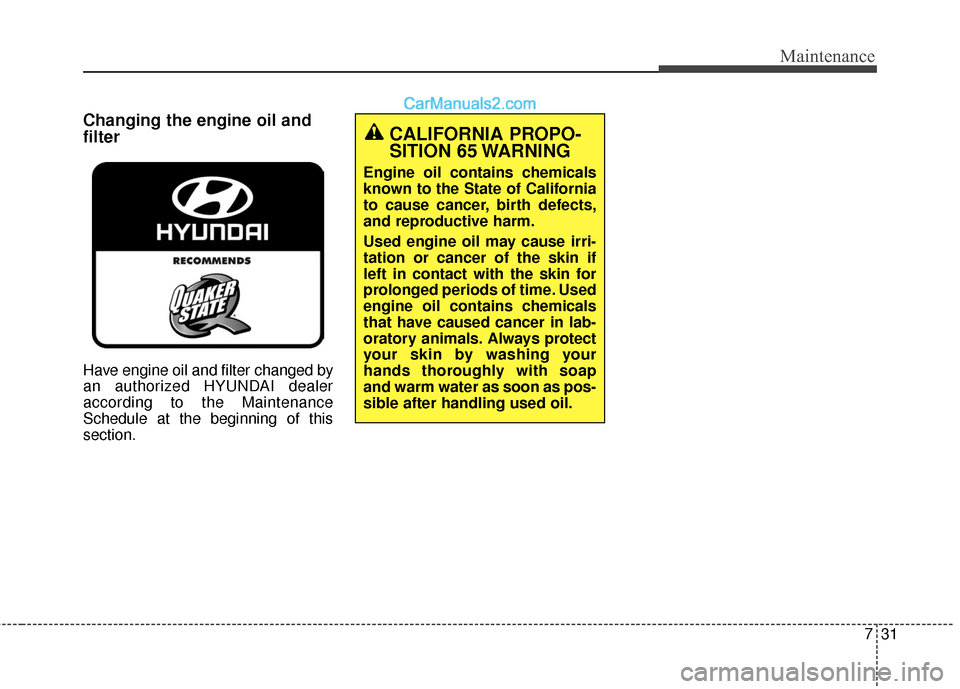
731
Maintenance
Changing the engine oil and
filter
Have engine oil and filter changed by
an authorized HYUNDAI dealer
according to the Maintenance
Schedule at the beginning of this
section.
CALIFORNIA PROPO-
SITION 65 WARNING
Engine oil contains chemicals
known to the State of California
to cause cancer, birth defects,
and reproductive harm.
Used engine oil may cause irri-
tation or cancer of the skin if
left in contact with the skin for
prolonged periods of time. Used
engine oil contains chemicals
that have caused cancer in lab-
oratory animals. Always protect
your skin by washing your
hands thoroughly with soap
and warm water as soon as pos-
sible after handling used oil.
Page 484 of 570

Maintenance
36
7
WARNING - Brake fluid
When changing and adding
brake fluid, handle it carefully.
Do not let it come in contact
with your eyes. If brake fluid
should come in contact with
your eyes, immediately flush
them with a large quantity of
fresh tap water. Have your eyes
examined by a doctor as soon
as possible.
CAUTION
Do not allow brake fluid to con-
tact the vehicle's body paint, aspaint damage will result. Brakefluid, which has been exposedto open air for an extended timeshould never be used as itsquality cannot be guaranteed. Itshould be disposed of properly.Do not put in the wrong type offluid. A few drops of mineral-based oil, such as engine oil, inyour brake system can damagebrake system parts.
Page 495 of 570

747
Maintenance
Reset items
Items should be reset after the bat-
tery has been discharged or the bat-
tery has been disconnected.
Auto up/down window (See section 4)
Sunroof (See section 4)
Trip computer (See section 4)
Climate control system (See section 4)
Clock (See section 4)
Audio (See section 4)(Continued)
Disconnect the battery charg- er in the following order.
1. Turn off the battery charger main switch.
2. Unhook the negative clamp from the negative battery
terminal.
3. Unhook the positive clamp from the positive battery
terminal.
Before performing mainte- nance or recharging the bat-
tery, turn off all accessories
and stop the engine.
The negative battery cable must be removed first and
installed last when the battery
is disconnected.WARNING- Rechargingbattery
When recharging the battery,
observe the following precau-
tions:
The battery must be removed
from the vehicle and placed in
an area with good ventilation.
Do not allow cigarettes, sparks, or flame near the battery.
Watch the battery during charging, and stop or reduce
the charging rate if the battery
cells begin gassing (boiling)
violently or if the temperature
of the electrolyte of any cell
exceeds 120°F (49°C).
Wear eye protection when checking the battery during
charging.
(Continued)
Page 512 of 570
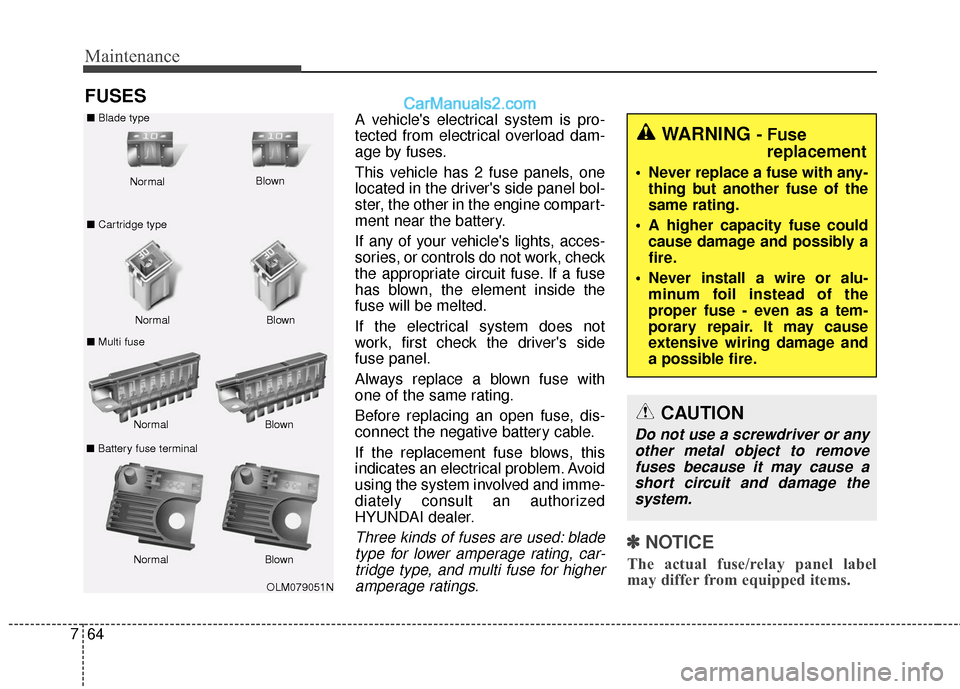
Maintenance
64
7
FUSES
A vehicle's electrical system is pro-
tected from electrical overload dam-
age by fuses.
This vehicle has 2 fuse panels, one
located in the driver's side panel bol-
ster, the other in the engine compart-
ment near the battery.
If any of your vehicle's lights, acces-
sories, or controls do not work, check
the appropriate circuit fuse. If a fuse
has blown, the element inside the
fuse will be melted.
If the electrical system does not
work, first check the driver's side
fuse panel.
Always replace a blown fuse with
one of the same rating.
Before replacing an open fuse, dis-
connect the negative battery cable.
If the replacement fuse blows, this
indicates an electrical problem. Avoid
using the system involved and imme-
diately consult an authorized
HYUNDAI dealer.
Three kinds of fuses are used: blade
type for lower amperage rating, car-tridge type, and multi fuse for higheramperage ratings.✽ ✽ NOTICE
The actual fuse/relay panel label
may differ from equipped items.
OLM079051N
Normal
Normal
■
Blade type
■ Cartridge type
■ Multi fuse Blown
Blown
Normal Blown
Normal Blown
WARNING - Fuse
replacement
Never replace a fuse with any-
thing but another fuse of the
same rating.
A higher capacity fuse could cause damage and possibly a
fire.
Never install a wire or alu- minum foil instead of the
proper fuse - even as a tem-
porary repair. It may cause
extensive wiring damage and
a possible fire.
CAUTION
Do not use a screwdriver or anyother metal object to removefuses because it may cause ashort circuit and damage thesystem.■ Battery fuse terminal
Page 536 of 570
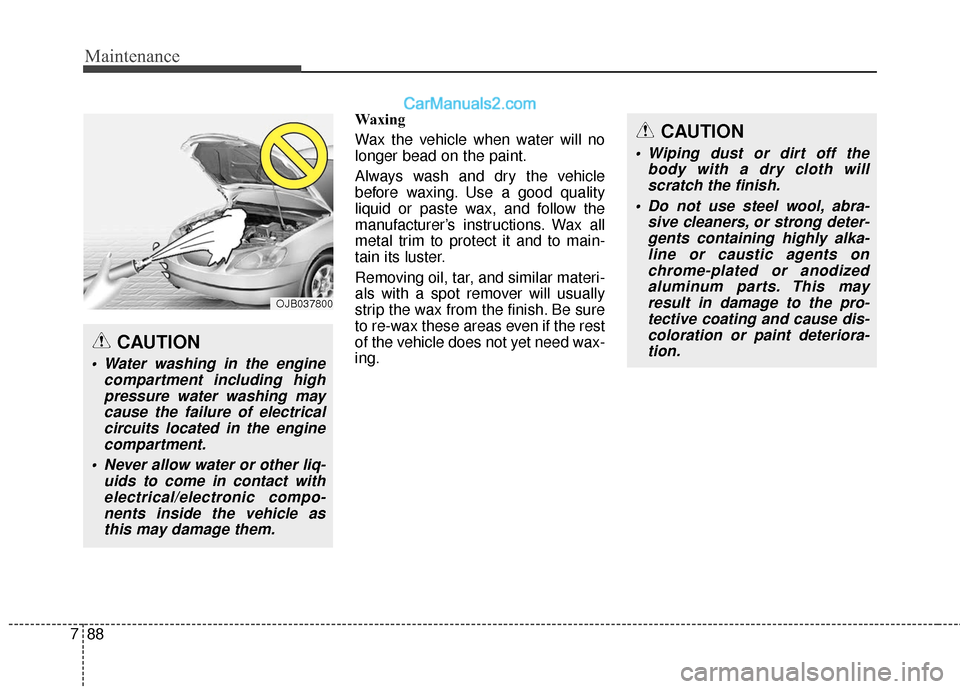
Maintenance
88
7
Waxing
Wax the vehicle when water will no
longer bead on the paint.
Always wash and dry the vehicle
before waxing. Use a good quality
liquid or paste wax, and follow the
manufacturer’s instructions. Wax all
metal trim to protect it and to main-
tain its luster.
Removing oil, tar, and similar materi-
als with a spot remover will usually
strip the wax from the finish. Be sure
to re-wax these areas even if the rest
of the vehicle does not yet need wax-
ing.CAUTION
Wiping dust or dirt off the
body with a dry cloth willscratch the finish.
Do not use steel wool, abra- sive cleaners, or strong deter-gents containing highly alka-line or caustic agents onchrome-plated or anodizedaluminum parts. This mayresult in damage to the pro-tective coating and cause dis-coloration or paint deteriora-tion.
CAUTION
Water washing in the engine compartment including highpressure water washing maycause the failure of electricalcircuits located in the enginecompartment.
Never allow water or other liq- uids to come in contact withelectrical/electronic compo-nents inside the vehicle asthis may damage them.
OJB037800
Page 554 of 570
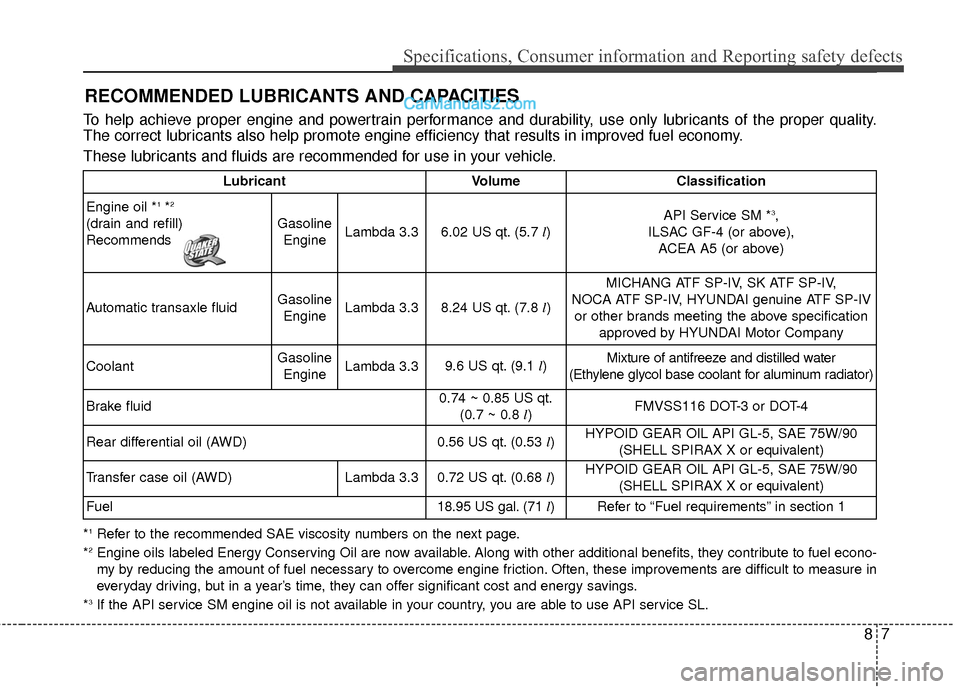
87
Specifications, Consumer information and Reporting safety defects
RECOMMENDED LUBRICANTS AND CAPACITIES
*1Refer to the recommended SAE viscosity numbers on the next page.
*2Engine oils labeled Energy Conserving Oil are now available. Along with other additional benefits, they contribute to fuel econo -
my by reducing the amount of fuel necessary to overcome engine friction. Often, these improvements are difficult to measure in
everyday driving, but in a year’s time, they can offer significant cost and energy savings.
*
3If the API service SM engine oil is not available in your country, you are able to use API service SL.
To help achieve proper engine and powertrain performance and durability, use only lubricants of the proper quality.
The correct lubricants also help promote engine efficiency that results in improved fuel economy.
These lubricants and fluids are recommended for use in your vehicle.
Lubricant VolumeClassification
Engine oil *
1*2
(drain and refill)
Recommends Gasoline
Engine Lambda 3.3
6.02 US qt. (5.7
l) API Service SM *3,
ILSAC GF-4 (or above), ACEA A5 (or above)
Automatic transaxle fluid Gasoline
Engine Lambda 3.3
8.24 US qt. (7.8
l)MICHANG ATF SP-IV, SK ATF SP-IV,
NOCA ATF SP-IV, HYUNDAI genuine ATF SP-IV or other brands meeting the above specification approved by HYUNDAI Motor Company
Coolant Gasoline
Engine Lambda 3.3
9.6 US qt. (9.1
l)Mixture of antifreeze and distilled water
(Ethylene glycol base coolant for aluminum radiator)
Brake fluid0.74 ~ 0.85 US qt. (0.7 ~ 0.8 l)FMVSS116 DOT-3 or DOT-4
Rear differential oil (AWD) 0.56 US qt. (0.53 l)HYPOID GEAR OIL API GL-5, SAE 75W/90
(SHELL SPIRAX X or equivalent)
Transfer case oil (AWD) Lambda 3.3 0.72 US qt. (0.68
l)HYPOID GEAR OIL API GL-5, SAE 75W/90
(SHELL SPIRAX X or equivalent)
Fuel18.95 US gal. (71 l)Refer to “Fuel requirements” in section 1
Page 555 of 570
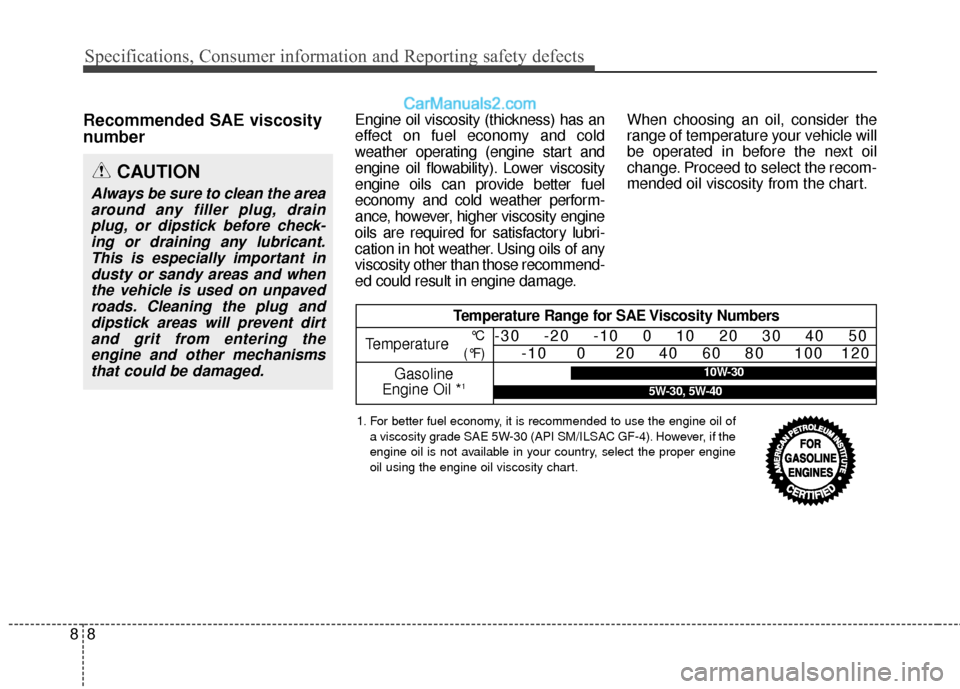
Specifications, Consumer information and Reporting safety defects
88
Recommended SAE viscosity
number Engine oil viscosity (thickness) has an
effect on fuel economy and cold
weather operating (engine start and
engine oil flowability). Lower viscosity
engine oils can provide better fuel
economy and cold weather perform-
ance, however, higher viscosity engine
oils are required for satisfactory lubri-
cation in hot weather. Using oils of any
viscosity other than those recommend-
ed could result in engine damage.When choosing an oil, consider the
range of temperature your vehicle will
be operated in before the next oil
change. Proceed to select the recom-
mended oil viscosity from the chart.
CAUTION
Always be sure to clean the area
around any filler plug, drainplug, or dipstick before check-ing or draining any lubricant.This is especially important industy or sandy areas and whenthe vehicle is used on unpavedroads. Cleaning the plug anddipstick areas will prevent dirtand grit from entering theengine and other mechanismsthat could be damaged.
Temperature Range for SAE Viscosity Numbers
Temperature
Gasoline
Engine Oil *
1
°C
(°F)-30 -20 -10 0 10 20 30 40 50 -10 0 20 40 60 80 100 120
10W-30
5W-30, 5W-40
1. For better fuel economy, it is recommended to use the engine oil of
a viscosity grade SAE 5W-30 (API SM/ILSAC GF-4). However, if the
engine oil is not available in your country, select the proper engine
oil using the engine oil viscosity chart.
Page 563 of 570
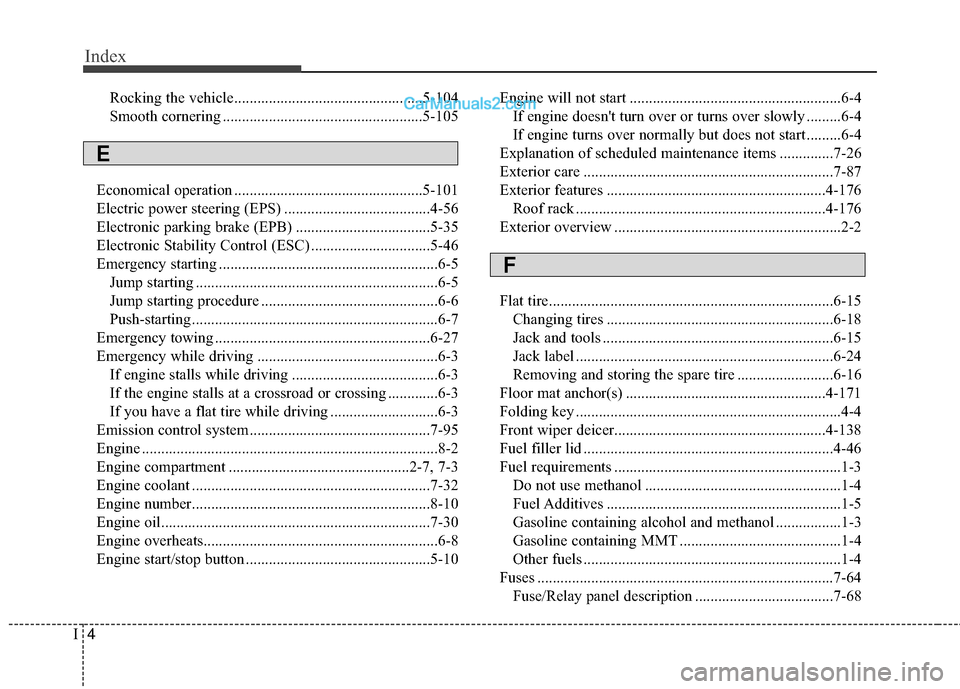
Index
4I
Rocking the vehicle.................................................5-104
Smooth cornering ....................................................5-105
Economical operation .................................................5-101
Electric power steering (EPS) ......................................4-56
Electronic parking brake (EPB) ...................................5-35
Electronic Stability Control (ESC) ...............................5-46
Emergency starting .........................................................6-5 Jump starting ...............................................................6-5
Jump starting procedure ..............................................6-6
Push-starting ................................................................6-7
Emergency towing ........................................................6-27
Emergency while driving ...............................................6-3 If engine stalls while driving ......................................6-3
If the engine stalls at a crossroad or crossing .............6-3
If you have a flat tire while driving ............................6-3
Emission control system ...............................................7-95
Engine ........................................................................\
.....8-2
Engine compartment ...............................................2-7, 7-3
Engine coolant ..............................................................7-32
Engine number..............................................................8-10
Engine oil......................................................................7-\
30
Engine overheats.............................................................6-8
Engine start/stop button ................................................5-10 Engine will not start .......................................................6-4
If engine doesn't turn over or turns over slowly .........6-4
If engine turns over normally but does not start .........6-4
Explanation of scheduled maintenance items ..............7-26
Exterior care .................................................................7-87
Exterior features .........................................................4-176 Roof rack .................................................................4-176
Exterior overview ...........................................................2-2
Flat tire........................................................................\
..6-15 Changing tires ...........................................................6-18
Jack and tools ............................................................6-15
Jack label ...................................................................6-24
Removing and storing the spare tire .........................6-16
Floor mat anchor(s) ....................................................4-171
Folding key .....................................................................4-4\
Front wiper deicer.......................................................4-138
Fuel filler lid .................................................................4-46
Fuel requirements ...........................................................1-3 Do not use methanol ...................................................1-4
Fuel Additives .............................................................1-5
Gasoline containing alcohol and methanol .................1-3
Gasoline containing MMT ..........................................1-4
Other fuels ...................................................................1-4
Fuses ........................................................................\
.....7-64 Fuse/Relay panel description ....................................7-68
E
F